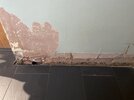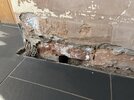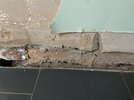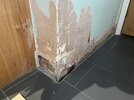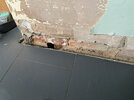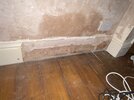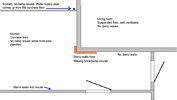Hi all, internal wall was showing signs of damp (paint had gone darker, damp to touch). I took the lining paper away and found the plaster damp. I then removed the skirting board to find what you see in the pictures.
There is a water pipe somewhere in the general vicinity of this wall, which goes from the incoming supply over to the utility room. The pipe will be buried as this floor is concrete (contrary to the rest of the downstairs which is suspended). I don’t believe this is the cause of the damp wall however, just because I’d expect the floor to be wet.
As you’ll see from the pictures, the damp is confined to one corner. In this corner is a missing brick (and a damp course) revealing a rotten piece of timber (which I assume is a joist which once served the room or a joist poking through from the suspended floor of the room behind).
No damp on the other side of the wall, so I’m assuming this whole problem stems from the lack of damp course. You’ll see the bricks to the right of the damp area are dry, and there appears to be a charcoal damp course doing its job.
If I’m right, how would I re-instate a damp course here?
There is a water pipe somewhere in the general vicinity of this wall, which goes from the incoming supply over to the utility room. The pipe will be buried as this floor is concrete (contrary to the rest of the downstairs which is suspended). I don’t believe this is the cause of the damp wall however, just because I’d expect the floor to be wet.
As you’ll see from the pictures, the damp is confined to one corner. In this corner is a missing brick (and a damp course) revealing a rotten piece of timber (which I assume is a joist which once served the room or a joist poking through from the suspended floor of the room behind).
No damp on the other side of the wall, so I’m assuming this whole problem stems from the lack of damp course. You’ll see the bricks to the right of the damp area are dry, and there appears to be a charcoal damp course doing its job.
If I’m right, how would I re-instate a damp course here?


